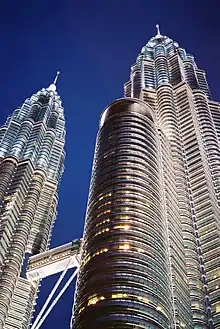Hazama Ando
Hazama Ando Corporation (株式会社安藤・間, Kabushiki-gaisha Andō Hazama, also called 安藤ハザマ), is one of the 10 biggest construction companies in Japan. It was launched in 2013 by the merger of the Hazama Corporation and Ando Corporation.[3] It has overseas offices in Asia, especially in the South Asian countries like Nepal, as well as in the United States, Mexico, Central and South America.
 | |
Native name | 株式会社安藤・間 |
|---|---|
| Type | Public (K.K) |
| TYO: 1719 | |
| Industry | Construction |
| Predecessor | Hazama Corporation Ando Corporation |
| Founded | (April 1, 2013) (through merger) |
| Headquarters | Akasaka, Minato-ku, Tokyo 107-8658, Japan |
Key people | Toshio Ono (Chairman of the Board of Directors) Masato Fukutomi (President) |
| Services |
|
| Revenue | |
Number of employees | 3,850 (consolidated, as of April 1, 2017) |
| Subsidiaries | Hazama Ando Kogyo Hazama Ando (Thailand) Aoyama Kiko Hazama Ando Singapore Hazama Ando Malaysia |
| Website | Official website |
| Footnotes / references [1][2] | |
History
The predecessors of the current company, Hazama and Ando, were established in 1889 and 1873 respectively. The two companies originally formed a capital and business tie-up in 2003, and were collaborating over order receipts and materials procurement before the merger.[3]
Selected Projects
- Tokyo's Ginza Subway Line (1933)
- Kanmon Bridge (1971)
- Monseñor Óscar Arnulfo Romero International Airport - San Salvador (1980)
- One Raffles Place - Singapore (1986)[4]
- Autopolis - Hita, Japan (1989)[5]
- Kansai International Airport (1989)[6]
- Tokyo Big Sight (1995)
- New Choluteca Bridge - Choluteca, Honduras (1998)
- Kelana Jaya Line underground section (Masjid Jamek-Ampang Park), 1998[7]
- Petronas Twin Towers (Tower 1) - Kuala Lumpur (1998)[8]

The Petronas Twin Towers. One of the towers was built by Hazama.
- Chubu Centrair International Airport (airport island reclamation) (2003)
- Hải Vân Tunnel (2005)[9]
- Subic–Clark–Tarlac Expressway - Manila (2008)[10]
- Algeria East–West Highway (eastern section) (2011)[11]
See also
References
- "Corporate Profile". Hazama Ando Corporation. Retrieved April 10, 2015.
- "Company Profile". Nikkei Asian Review. Nikkei Inc. Retrieved September 1, 2017.
- "Contractors Hazama, Ando announce 2013 merger". Japan Times. May 25, 2012. Retrieved April 10, 2015.
- Binder, Georges (2006). 101 of the World's Tallest Buildings. Images Publishing. p. 107. ISBN 978-1-86470-173-9.
- Mende, Kaoru; Lighting Planners Associates Inc. (2000). Designing With Light and Shadow. Images Publishing. p. 177. ISBN 978-1-86470-041-1.
- Bachman, Leonard R. (January 27, 2004). Integrated Buildings: The Systems Basis of Architecture. John Wiley & Sons. p. 232. ISBN 978-0-471-46774-8.
- "Light Railway Transit (LRT) of Kuala Lumpur, Tunnel Work". Retrieved 19 December 2018.
- Binder, Georges (2006). 101 of the World's Tallest Buildings. Images Publishing. p. 31. ISBN 978-1-86470-173-9.
- "Hai Van Tunnel Construction Project". Japan International Cooperation Agency. August 21, 2017. Retrieved September 10, 2017.
- Hermoso, Tito F. (September 5, 2017). "SCTEx: Built against all odds". AutoIndustriya.com. Archived from the original on September 13, 2017. Retrieved September 13, 2017.
- The Report: Algeria 2011. Oxford Business Group. 2011. pp. 134–136. ISBN 978-1-907065-37-8.
This article is issued from Wikipedia. The text is licensed under Creative Commons - Attribution - Sharealike. Additional terms may apply for the media files.